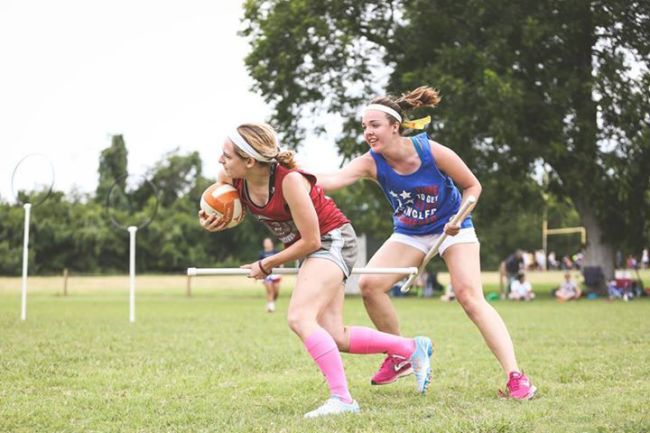
Five years ago Lizzie Wilson, an environmental engineering and French double major at SMU, was walking through Boston when she came across a group of people playing quidditch, a sport invented by J.K. Rowling in the magical Harry Potter series.
“There was this team playing, I’m pretty sure it was Boston College, and I was just like ‘this is so weird,” said Wilson. “I took pictures of it and sent it to my friends, but now that I’m part of it, it doesn’t seem weird at all.”
Wilson’s initial reaction to the sport was not strange, since players are required to run the field with a broomstick between their legs for the whole game.
“It takes a few times to get used to holding a stick between your legs,” said Wilson. “It was taught to me like this: hockey you play on ice, quidditch you play with a stick between your legs, it’s just a natural handicap of the game.”
Students on the SMU campus have had similar reactions upon seeing quidditch for the first time. Sydne Armstrong, a recent SMU graduate, remembers returning to campus and seeing students playing quidditch on the lawn of Dallas Hall.
“I had no idea what was going on,” said Armstrong. “I thought it was pretty weird but it looked like they were having fun.”
Since her first time seeing quidditch, Wilson has gotten the opportunity to play and has fallen in love with the sport and the community she has found within it. Wilson founded SMU Quidditch in the fall of 2014 and she is currently serving as the captain.
In Harry Potter, quidditch is played on flying broomsticks, which is not feasible for muggles like us. In 2005 a freshman at Middlebury College in Vermont adapted the game for the non-magical and the sport has been rapidly growing ever since. There are currently 116 official quidditch teams at universities and 42 community teams throughout the country.
SMU Quidditch is hoping to become officially recognized as a club team by the university within the next year. Currently, the team is playing for fun and has no university or official US Quidditch affiliation. US Quidditch is the organization that governs the sport in America. Last fall the team had one scrimmage against University of North Texas. They won the match, but have not gotten the opportunity to play any since.
“What’s really cool about quidditch, especially in the fall, is that there are a lot of unofficial tournaments,” said Wilson. “You don’t have to be official yet, so it’s a great way to get players into the game without the commitment of being an official team.”
All quidditch teams are co-ed and consist of seven players. There are three chasers, identified by a white headband, who score goals by passing, running, and kicking their respective volleyballs down the field and through the other team’s hoops. There is one keeper per team, identified by a green headband, who defends the goals. There are two beaters, identified by black headbands, who use dodgeballs as “bludgers” and try to knock out the other players. When a player is hit with a bludger, they are out of play until they touch their own goalpost. There is one seeker per team, identified by a yellow headband, who is trying to catch the snitch.
In the Potter books, the snitch is a golden ball with wings that flies around the field. In the real world, the snitch is a neutral player who wears an all yellow ensemble with a ball attached to the waistband. In order to maintain neutrality and fairness, people who want to be snitches have to take an exam and become certified by US Quidditch. The snitch comes onto the field 15 minutes into the game and tries to avoid being caught by the seekers.
Wilson said she has heard of a “snitch culture” in the quidditch world.
“One of my friends who was a snitch used to wear a yellow gas mask during every game,” said Wilson. “People will wear different outfits and some snitches will have signature outfits. I’ve never seen it in tournaments, but I’ve heard of it.”
Quidditch brings the fantasy world of Harry Potter to life for many superfans, but to many players it is much more than that. Hal Hoeppner, a member of SMU Quidditch, had read the books but says that he is not a die-hard fan.
“I am by no means an athlete,” said Hoeppner, “I just really like quidditch because I get to run around with cool people for a few hours, laughing when I wipe out trying to catch a pass, and cheering when my teammates make an awesome shot.”
Hoeppner found SMU Quidditch from a flyer that had been left on a table in Umphrey Lee one day last fall, then he joined the Facebook group and started going to practices.
Although Hoeppner does not consider himself an athlete, the game of quidditch is very physical. According to Wilson, there are some ex-high school football players who play the highly competitive full-contact sport.
“It’s almost too competitive,” said Wilson. “I think because it’s a smaller community people know each other and it’s almost personal.”
Although the sport has been increasing in popularity for the past ten years, some people are still not aware that it has been adapted to play in real life.
“When I first heard that there was a quidditch team on campus I didn’t believe it,” said Catherine Huff, a senior at SMU. “I haven’t seen them practice but I have seen a flyer or two lying around.”
Wilson describes the sport as a combination of lacrosse, rugby, dodgeball and football. The team at SMU is not yet registered with US Quidditch, but Wilson is hoping that it will be official by next fall. Wilson will be attending graduate school at SMU next year, so she will be able to help the fledgling team grow.








